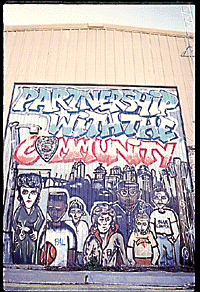1% for Soul
Weighing the Costs of the Art in Public Places Program
By Rebecca S. Cohen, Fri., March 7, 1997

Ceramic Quilts at South Austin Senior Activity Center |

Graffiti mural at the East Austin Police Substation |
Peters talks convincingly about how important it is for activity centers, libraries, and even police substations to reflect their particular neighborhoods. "There are a lot of little cities within the city," she says of Austin. Each one is "filled with individuals making the community a better place to live." The AIPP program is a way that the city can help these individual communities be better places. "If it [the AIPP project] has meaning for the community, it's successful," says Peters. "But if it also has aesthetic merit, that's the ultimate, the ideal, the reason we're doing it."
The South Austin Senior Activity Center achieves this ideal. It clearly belongs to its community, which evidences considerable pride of ownership. It is also of high quality technically and aesthetically. "If public buildings are purely functional, there's no human element," says Peters. Art adds that human element, she says, whether by using a broken piece of an old woman's wedding china or casting the handprints of workers in the neighboring facility (St. Elmo Service Center, Wall of Hands), or having homeless people help collect objects from around the site and incorporating those objects into the art for the site (Austin Convention Center, The Waller Creek Shelves).
In 1985, Austin became the first municipality in Texas to commit 1% of the budgets for new city construction projects to the commission or purchase of art to be displayed on site. The ordinance includes facilities such as Robert Mueller Airport and the new Austin-Bergstrom International Airport, the convention center, libraries, parks, police stations, and recreation centers. The AIPP panel, which is appointed by the Austin Arts Commission, meets monthly to plan public art projects, recommend selection processes, and appoint artist selection panels. Peters is now working with 20 active contracts, and three or four more are about to go out for selection. A spiffy new brochure, supported by a grant from the Texas Commission on the Arts, lists all the AIPP projects that have been realized or begun to date, providing Austinites with the means to take a self-guided tour of the art we've purchased. Some of the brochure photographs of AIPP projects were taken by the multi-talented program director.
Peters, whose job includes negotiating contracts between the city and artists, and "holding the hands" of both bureaucrats and artists, seems ideally suited to the task. She studied sculpture and photography at UT Austin, graduating with a BFA, and worked for the Texas Historical Commission (THC) before moving to the AIPP job in 1991. Peters says she honed her political skills at the THC and so was ready for the challenges that the AIPP job provides. At least most of them.

The Howson Branch Library's mixed media window |
The Howson Branch Library's mixed media window, which separates a new reading room from the rest of the library, is another case in point. AIPP was invited to participate in the project, which was made possible by Mrs. Louis Southerland's donation of funds in memory of her husband. With AIPP's assistance, Sandra Fiedorek and David Heymann were chosen to realize their playful proposal. A coded message and the figure of a man read the same from either side of the glass. The artists' message uses only letters that look the same forward or backward, like "s" and "o" and "t." They leave spaces for the others. Martha interpreted the code as best she could. She also rearranged a chair inside the reading room which obstructed the piece. One of the problems, she says, with public art is what happens after officials leave the facility to its constituency.

Within Damian Priour's hanging glass bowls in the
convention center are spectacles, a baby shoe, a high-heeled shoe -- remnants
and reminders of lives that have been lived in Austin |
"There's no predicting," says Peters, which project will run into trouble. Everett speaks stoically of the experience and only in glowing terms of the program's director. She, in turn, is quick to point out that it was the library and not the artist that missed its deadline. "He (Everett) rushed to finish," she says.
At the East Austin Police Substation on Springdale Road, the Austin League of Minority Artists (ALMA) was chosen to paint a graffiti-style mural on the outside of the building, as if to preclude anyone else from marking the wall. Can anyone resist the irony of paying young people with spray paint to enhance the exterior of a police substation? Unfortunately, the architecture of the building seems to not want to have anything to do with Felipe Garza, Armando Martinez, and Raymond Martinez's mural, which was added after the building was complete.
Similarly, art for the Austin Convention Center was chosen after the building was complete. The center was, then wasn't, then did get to have art through AIPP. The last of four projects, 20 oil paintings by Jill Bedgood entitled Texas Botanicals should be finished in the next couple of months and installed by late spring or early summer. Ben M. Livingston's Confabulating Orbits, two neon and copper orbs mounted in the southwestern corner of level one at the convention center, serve as a graphic reminder of the pitfalls of waiting for a building to be complete before choosing art. A very long cord runs down from one of the circular objects to a plug near the floor. Plans to electrify the piece in a more aesthetic manner are under way. The ceramic tile mosaic by John A. Yancey and Steve Jones that hangs on a wall near Livingston's piece is beautiful, but sited so high and so close to the opposite wall that it's hard to see easily without craning your neck.

Fidencio Durán mural in Parque Zaragoza Recreation Center building |
Sandra Fiedorek had a similar close call last November when a newly configured Airport Advisory Panel attempted to have the city council revoke approval of the artist's proposed mural for the new airport. Even though Fiedorek's proposal had been one of the top four selected through an intricate process (involving approval by a specially appointed AIPP jury, the Airport Advisory Panel, the Austin Art Commission, and an earlier city council), it was suddenly in danger. Some lobbying of councilmembers by the artist and an effort to quickly educate those concerned saved the day.
Priour's proposal, on the other hand, generated so much press over time, that he bound the articles together and put them in one of the hanging glass bowls in the convention center. In other vessels are spectacles, a high-heeled shoe, a baby shoe -- remnants and reminders of lives that have been lived in Austin.
It is this ability of artists to embody the spirit of Austin through public art projects that keeps the tiny AIPP staff going. Peters and a half-time assistant, Julie Butridge, who also programs the Dougherty Art Center gallery, clearly feel their efforts are worthwhile. "If a government forgets to encourage cultural development, there's no soul," Peters says. One percent of the budgets for certain city building projects seems like a small price to pay to enhance Austin's soul -- and, subsequently, our own.








